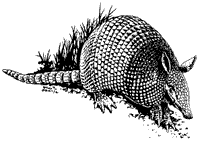|
Armadillos | Armadillo Overview | Armadillo Damage Assessment | Armadillo Damage Management | Armadillo Resources | Armadillo Acknowledgments | ICWDM | Wildlife Species Information |
Damage and Damage Identification

Most armadillo damage occurs as a result of their rooting in lawns, golf courses, vegetable gardens, and flower beds. Characteristic signs of armadillo activity are shallow holes, 1 to 3 inches (2.5 to 7.6 cm) deep and 3 to 5 inches (7.6 to 12.7 cm) wide, which are dug in search of food. They also uproot flowers and other ornamental plants. Some damage has been caused by their burrowing under foundations, driveways, and other structures. Some people complain that armadillos keep them awake at night by rubbing their shells against their houses or other structures.
There is evidence that armadillos may be responsible for the loss of domestic poultry eggs. This loss can be prevented through proper housing or fencing of nesting birds.
Disease is a factor associated with this species. Armadillos can be infected by the bacterium Mycobacterium leprae, the causative agent of leprosy. The role that armadillos have in human infection, however, has not yet been determined. They may pose a potential risk for humans, particularly in the Gulf Coast region.
Legal Status
Armadillos are unprotected in most states.
Economics of Damage and Control
There are few studies available on the damage caused by armadillos. The damage they do is localized and is usually more of a nuisance than an economic loss.
|
Armadillos | Armadillo Overview | Armadillo Damage Assessment | Armadillo Damage Management | Armadillo Resources | Armadillo Acknowledgments | ICWDM | Wildlife Species Information |
